Читать книгу Everest Here Continents Collided - Alex W Milne - Страница 8
На сайте Литреса книга снята с продажи.
Chapter 1 Plates Collide
ОглавлениеThe Himalaya is a continental collision of epic proportions. The product of the collision between the Indian plate to the south and the Eurasian plate to the north, that started 70 million years ago, as India headed towards Eurasia, consuming the intervening Tethyan ocean. The collision is ongoing today. It is a collision full of amazing features:
To the north the Tibetan Plateau has been uplifted 5 kms from sea level.
The average height of the Himalaya is also 5kms. Evidence of continental thickening.
An estimated 2000 - 2500 kms of convergence between the Indian and Eurasian continents over a 50 million year period (see diagram below). Followed by 20 million years of collision. On the geological timescale a relatively recent event.
The Himalayan mountains are formed by crustal faulting and uplift. In any plate tectonic reconstruction a key feature is the the recognition of the suture, or join, between colliding continents. The location and nature of the suture is illustrated in the cross section below. The suture between the two plates is believed to be the Indus Tsangpo suture in southern Tibet. This assumption is based on the presence of marine Tethyan ocean sediments within the suture.
What are the rocks in the collision zone? How old are they? In the case of the Himalaya a model of crustal scale thrusting has been developed. The father of this model was the Swiss geologist Emile Argand, crucially, he postulated that India was subducting, i.e. pushing beneath, Eurasia and creating the Tibetan plateau. Subsequently the nature of the thickening was debated in the 1970 and 1980’s by John Dewey and Molnar and Tapponier, Philip England and Greg Houseman. Molnar and Tapponier believed that the Tethyan oceanic crust was largely extruded or squeezed sideways, whereas Dewey believed that the oceanic crust was accreted onto the passive Indian continental margin.
More recently the work of Mike Searle at Oxford University has demonstrated how the accreting leading edge of the India plate has been uplifted and thrust through time. It is these rocks and geological structures that you observe while walking from Lukla up to Everest. The trekker is in effect walking directly into and observing the products of the continental collision. He is walking into and viewing a spectacular example of the Earth's crust that has been brought to surface from 20 kms down and folded and faulted and thrust during 20 million years of continent to continent collision.
Ideally if time allows, I recommend you take the Everest flight first and see it all on a grand scale. The immense size and complexity of the Himalayan chain is clear to see from 20,000ft. What you see is the smashed up Earth's crust on the leading edge of the India plate.
Fifty million years getting there and then 20 million years building the Himalaya. - Source USGS.
Modified from the USGS. This diagram illustrates how, during collision, the Indian plate has subducted beneath the Eurasian plate. Over time the India plate has fragmented and been thrust back up to form the high Himalaya. As the Indian plate has pushed on the Eurasian plate the Tibetan Plateau has been uplifted. A remnant of the ancient oceanic crust has been trapped and preserved in the Indus Tsangpo suture zone.
Haze along the Himalaya
The Imaging Spectroradiometer (MODIS) on NASA’s Terra satellite captured this image in 2008. The image shows how narrow a strip the Himalaya occupies and how mountainous the Tibetan plain is compared to the Indian plain. This is because the Indian plate is pushing against the Eurasian plate causing it to uplift and buckle. The red dots are probably fires seen from space.
